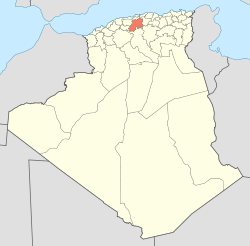Médéa
| Médéa المدية | |
|---|---|
| City | |
 | |
 | |
 Médéa | |
| Coordinates: 36°16′3″N 2°45′0″E / 36.26750°N 2.75000°E | |
| Country |
|
| Province | Mascara Province |
| District | Mascara District |
| Area | |
| • Total | 63.5 km2 (24.5 sq mi) |
| Elevation[1] | 1,036 m (3,399 ft) |
| Population (2008 census) | |
| • Total | 145,441 |
| • Density | 2,300/km2 (5,900/sq mi) |
| Postal code | 26000 |
Médéa (Arabic: المدية, pronounced Lemdiya), population 123,535 (1998 census) is the capital city of Médéa Province, Algeria. It is located roughly 83 km south of Algiers.
The present-day city is situated on the site of an ancient Roman military post and has a history dating back to the 10th century. The town is French in character, with a rectangular city plan, red tile-roofed buildings, and beautiful public gardens. The hills surrounding Médéa are covered with vineyards, orchards, and farms that yield abundant grain. Médéa’s chief products are wines, irrigation equipment, and various handicrafts.
Etymology
Médéa could be the ancient Roman post "Medix" or "ad Médias", so called because it was equidistant from Tirinadi (Berrouaghia) and Sufnsar (Amoura). Thus, the name has no etymological connection to Medea of Classical Mythology.
History
Médéa was the capital of Titteri; a Bey, deputy of the Dey of Algiers, was resident there. The beylik of Titteri (chief Medea) was established in 1548. The last Bey Mostefa Boumezrag ran it from 1819 to 1830, when the French arrived. In 1837, after the Treaty of Tafna, Medea became one of the capitals of the part of Algeria ruled by Abdelkader El Djezairi, but was occupied by the French when they eventually took possession of the whole of Algeria.
Economy
One of the largest pharmaceutical production units in Algeria (Saidal-Antibiotical) is located in Medea.
Shoe factories also established in Takbou and M'salah.

Famous people
- Amine Megateli - Professional footballer
- Jean Richepin - French poet and writer, member of Académie française
- Djamel Tlemçani - Professional footballer
- Mohamed Bousseria - Moudjahid
See also
References
| |||||||||||||||||
